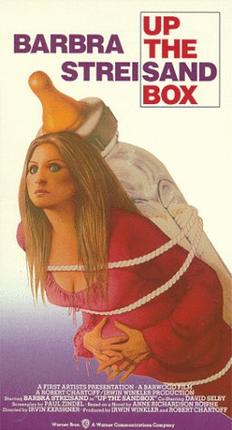Critical reception
Up the Sandbox was one of the early films to explore women's changing roles during the sexual revolution of the early 1970s, and critics praised Streisand's performance. According to Pauline Kael in The New Yorker , Streisand "never seemed so radiant as in this joyful mess, taken from the Anne Richardson Roiphe novel and directed by Irvin Kershner. The picture is full of knockabout urban humor". [10] Kael continued: "Barbra Streisand has never seemed so mysteriously, sensually fresh, so multi-radiant. As Margaret, wife of a Columbia instructor and mother-of-two, she's a complete reason for going to a movie, as Garbo was. If there is such a thing as total empathy, she has it." [9]
Roger Ebert, who gave the film three out of four stars, only had praise for her in his review: "This is a Barbra Streisand movie, and so we know the central character won't (can't) be stereotyped; nothing even remotely like Streisand has existed in movies before...She does not give us a liberated woman, or even a woman working in some organized way toward liberation. Instead, she gives us a woman who feels free to be herself, no matter what anyone thinks. This is a kind of woman, come to think of it, who is rare in American movies". [11]
Gary Arnold of The Washington Post wrote "Up the Sandbox is something rather special, a smart, imaginative, unconventional comedy about middle class married and domestic life that also is extraordinarily touching, truly loving. This is by several light years the most endearing and fundamentally joyous new movie the holiday season has to offer." [9]
Howard Thompson praised the film in a review published by The New York Times : "Barbra Streisand's sixth film is her sixth hit...it's hard not to think of this extraordinary young woman, perfectly wedded to the camera with her instant Modigliani face and timing. She's the picture, true, but the teamwork is admirable. Nearly everything works and meshes, starting with an adroit script by Paul Zindel...Fortunately and even when they're way out, the vignette musings generally miss blandness and strain because our heroine is a bright, likable girl, not a pinhead. Furthermore, Irvin Kershner has paced the picture—in which Miss Streisand plays a non-singing role — with a kind of take-it-or-leave-it verve that nimbly enhances the sharp dialogue, the more thoughtful passages and the performances." [12]
Rosalyn Drexler also wrote a review for The New York Times, criticizing the politics but praising the direction and performances: "Now, although Up the Sandbox purports to examine Margaret's changing role in relation to her husband, children, political reality, racial problems—anything and everything that touches upon herself and the rest of the world—it becomes a clumsy reaffirmation of the notion that staying at home and having babies is the best thing for a woman to do, especially if her husband “generously” likes babies and is willing to give her one day a week off...However, politics aside, Irvin Kershner, the director, is often really excellent: I loved his direction of a family get‐together on the occasion of Margaret's parents' 33rd wedding anniversary. During this party, a relative is shooting home movies the lighting, is blinding, and so‐called normal behavior becomes abnormal or forced. The actors perform within a performance: they realize that movies—home movies—are for posterity, a reservoir of information, a cheerful record... Barbra Streisand is Barbra Streisand (love her or leave her) trying to be ordinary, but being beautiful." [3]
Streisand's performance was also praised by her former husband, the actor, Elliott Gould in a 1973 interview with The New York Times: " Did you see her in Up the Sandbox? She's more refined in that than I've ever seen her before. I'm real proud of Barbra." [13]
On Rotten Tomatoes, the film has a 71% rating based on seven reviews. [14]
